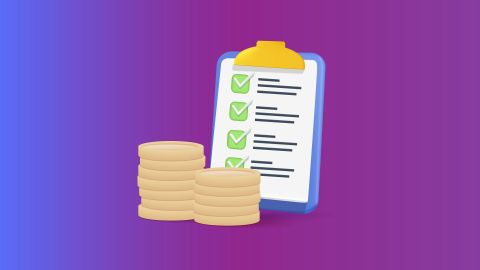Benefits of a restaurant business plan
- Provides a roadmap: A restaurant business plan gives you a clear roadmap for starting and running your restaurant efficiently.
- Helps secure funding: A well-crafted business plan can help secure funding from investors or lenders for your restaurant business. If you're starting small, applying for a micro loan can be a practical way to get initial capital without the burden of large repayments. You can also check your pre-approved business loan offer to explore faster, tailored financing opportunities.
- Lowers risk: Proper planning helps mitigate risks in your business operations.
- Measures of success: A business plan enables you to set measurable goals and track your restaurant's performance against them.
Why is a restaurant business plan important?
- Changing Customer Habits After Pandemic
Customers now want quick service, easy online ordering, fast delivery, and good hygiene. Your plan must show how you will meet these needs.
- More Competition and Rising Costs
- The restaurant market is crowded, and costs for ingredients, staff, and rent are increasing. Your plan should include pricing and sourcing strategies to handle these challenges.
- Use of Technology is Essential
- Digital tools like contactless payments, POS systems, and loyalty apps are now important. Your plan should explain how you will use technology to improve your business.
- Investors Expect More Details
- Investors want clear financial forecasts, market research, and a growth plan. A strong business plan helps you convince them you’re ready to succeed.
- Your Business Plan is Key
- It acts as your strategy guide, tech plan, and investor pitch—all in one.
A step-by-step guide on how to start a restaurant business in India
Starting a restaurant business in India demands strategic planning and attention to detail. Here's a concise step-by-step guide:
- Choose a restaurant concept
- Write a restaurant business plan
- Obtain restaurant funding
- Find a commercial space
- Plan your restaurant's layout
- Acquire restaurant permits and licenses
- Hire restaurant staff
- Advertise your restaurant
Step 1: Choose a restaurant concept
Your restaurant’s concept is the foundation of your brand. It defines the theme, cuisine, décor, and overall dining experience you want to offer. A clear concept helps you stand out, build your brand identity, and attract the right target audience—whether it’s a quick service outlet, fine dining restaurant, or a trendy café.
Step 2: Write a restaurant business plan
A detailed business plan acts as a roadmap for your restaurant. It should include your company overview, concept and menu, market analysis, staffing plan, marketing strategies, and financial projections. This document not only guides operations but also helps attract investors or secure loans by proving your concept is viable.
Step 3: Obtain restaurant funding
Opening a restaurant requires significant capital for rent, licenses, equipment, and salaries. You can explore funding options such as commercial loans, business lines of credit, small business loans, or even investors. Clearly estimating your startup costs helps you decide how much funding you’ll need and from which source.
Step 4: Find a commercial space
Location plays a huge role in a restaurant’s success. Analyse areas for customer demographics, accessibility, visibility, labour costs, and competition. Choosing the right commercial space ensures consistent footfall and long-term growth.
Step 5: Plan your restaurant’s layout
The layout impacts both customer satisfaction and staff efficiency. Focus on front-of-house areas like seating, décor, and ambiance, and back-of-house areas like kitchen, storage, and preparation zones. A well-thought-out design makes service smoother and enhances the dining experience.
Step 6: Acquire restaurant permits and licenses
To operate legally in India, restaurants require multiple licenses including FSSAI license, GST registration, health permits, liquor license (if applicable), and fire safety clearance. Ensuring compliance with local and national regulations protects your business from penalties and builds customer trust.
Step 7: Hire restaurant staff
A restaurant is only as good as its team. Hire skilled chefs, kitchen assistants, servers, and managers to ensure smooth operations and excellent service. Providing proper training, fair pay, and a positive work environment will help retain staff and maintain quality.
Step 8: Advertise your restaurant
Marketing is key to attracting customers. Use digital platforms like social media and Google listings, build a professional website, and offer promotions to first-time customers. Hosting a grand opening event can also create buzz and build visibility for your restaurant.
Registrations required to start a restaurant business in India
A restaurant owner needs to get several licences and registrations to run a restaurant business in India. Here are the important ones:
Registering Business Entity
To start a restaurant, the owner must first decide the business type. They can run the restaurant alone as a proprietorship or with partners as a partnership firm. They can also set up a private limited company.
Instead of a proprietorship or partnership, it is often better to choose a One Person Company (OPC) or a Limited Liability Partnership (LLP). Proprietorships and partnerships do not have a separate legal status and may find it harder to get funds compared to OPCs and LLPs. If the owner plans to open multiple outlets or franchise, a private limited company is usually best.
FSSAI License
The Food Safety and Standards Act, 2006 requires all Food Business Operators (FBO) to get an FSSAI license. This license shows that the restaurant meets government food safety standards. All restaurants, including cloud kitchens, must have either an FSSAI registration or license. The type depends on the restaurant’s turnover and capacity.
Shop and Establishment Act Registration
This registration is managed by the state’s Department of Labour. It covers all places where business is carried out, including restaurants. Every restaurant must apply for a Shop and Establishment Act Registration, issued by the State Chief Inspector of Labour.
Business License
A restaurant must get a trade license from the local municipal corporation. Without this, the restaurant can be shut down. Licenses must be renewed yearly. The owner also needs a No Objection Certificate (NOC) from at least three neighbours. If serving alcohol, a liquor license from the Local Excise Commissioner is needed. A fire department NOC is also required.
Eating House License
Any place serving food and drinks to the public is an eating house. Restaurants must get an eating house license from the local Police Commissioner.
GST Registration
All restaurants must register under GST. If a restaurant has outlets in different states, it needs a separate GST registration for each state.
Trademark Registration
If you plan to open a chain or invest in branding, it’s wise to get trademark registration for your restaurant’s name or brand. While not compulsory, it protects your brand from being used by others and prevents competitors from copying your name.
How can a business loan support your restaurant business plan?
A business loan can be a strong financial tool to turn your restaurant idea into reality. It helps you manage upfront expenses and ensures smooth operations in the early stages. Here’s how it can support your business:
- Cover setup costs: Funds can be used for renting or buying a commercial space, interior décor, and kitchen setup.
- Purchase equipment: A loan makes it easier to invest in ovens, grills, refrigerators, and other essential appliances.
- Working capital support: Helps manage day-to-day expenses like staff salaries, raw materials, and utility bills until revenue stabilises.
- Marketing and promotions: Extra funds allow you to invest in advertising, digital campaigns, and grand opening events to attract customers.
- Manage repayments easily: With a flexible tenure, you can plan your cash flow better. Use the Business Loan EMI Calculator to estimate your monthly outflow.
- Know the costs upfront: Check the applicable business loan interest rate to understand borrowing expenses before applying.
Apply for a Bajaj Finserv Business Loan to achieve your restaurant goals
A Bajaj Finserv Business Loan can help you achieve your restaurant goals such as expanding your business, refinancing debts, or launching new menus. With business loans, your restaurants can access funding to execute their business plans and make informed strategic decisions. You can also opt for a secured business loan if you wish to avail higher loan amounts or better interest rates by pledging assets.
Are you looking to start your own restaurant or grow your current business? Business loans can provide you with flexible and affordable financing options. Get started today and take advantage of our financing options to launch your restaurant and turn your dream into a reality.
In conclusion, creating a winning restaurant business plan can help you launch and manage your restaurant business successfully. Remember to incorporate key elements such as an executive summary, business description, market analysis, staffing, operations, and financial plan.
Helpful resources and tips for business loan borrowers






